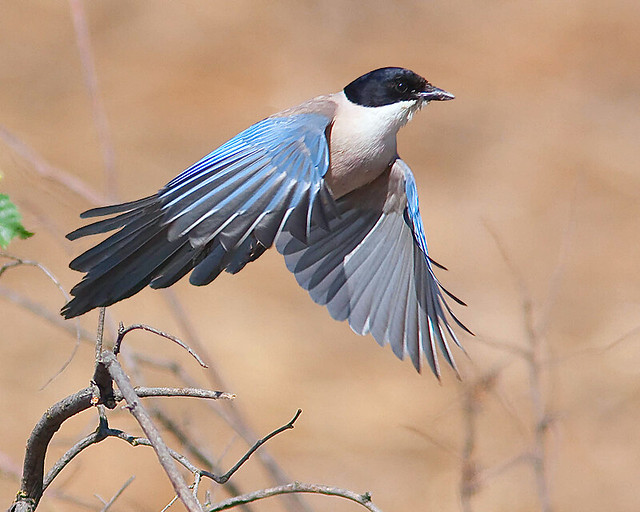Azure-winged Magpie
Blue Magpie ( Cyanopica cyana )
The Blue Magpie ( Cyanopica cyana ) is a species of bird that is native to the Iberian Peninsula and in East Asia.
Appearance
The 33-37 cm long blue magpie is very similar in physique of Elster, however, legs and beak are proportionately shorter.
She has a brown-gray to beige -colored belly. The back is dark to brown, the brown color gives way to the blue of the wings. The top of the head is shiny black. The white color of the throat occurs in a narrow lateral band to the neck. The tops of the wings and tail are azure blue and have helped her to her name. The tail is bright colored to white. In the blue of the wings and tail are typical of corvids structural colors, that is, the right light may seem bright azure, rather covered in bad weather.
Distribution and population
The distribution of blue magpie is dissected in two widely separated populations. The one located in southwestern Europe on the Iberian Peninsula, the other, much larger in East Asia. There they colonized large parts of China, Korea, Japan and the southern Mongolia.
Only one of the eight subspecies - C. c. cooki - occurs in Europe. On the origin of this extensive enclave there are several theories.
Firstly, it is assumed that it has formerly been a continuous population between the Mediterranean basin and East Asia. The glaciation during the Ice Age resulted in a population decline and to a division of the range. Another theory suggested that the European population is not indigenous and that the handsome bird in historical times (ca. 16th century ) was introduced by Portuguese sailors. Since the subspecies cooki was already described in 1830 and demarcated from other subspecies, but there are legitimate doubts about this theory: It is unlikely that in the course of 200 years, there has been a significant cleavage so.
More recent genetic studies show that the population of Europe differs so significantly that they own kind - Cyanopica cooki - forms. However, this has so far not officially recognized.
According to the European Bird Census Council of the European population in Portugal and Spain is 260000-460000 breeding pairs. The stocks are stable.
Habitat
The Blue Magpie is on the Iberian peninsula, a typical bird of the open tree landscapes in the open, evergreen forests often it occurs from cork and other oak species (eg oak, Pyrenean oak ), sparse pine forest, pine - oak mixed forests and pine forests ( eg Aleppo pine ) on.
They preferably less closed forest areas, but rather the permeated by pasture or orchards, extensively used cultural landscape. Particularly high population densities it reaches therefore in Extremadura, in western Andalusia and in southern Portugal.
On the edge of its range, the blue magpie is less picky and colonized landscapes with almond trees and olive groves.
Limited is the spread in the European part of the range by the lack of suitable habitats, but also by the competition for magpie. The two species occur in the Iberian Peninsula as well as never before together.
In the Asian part of the range the blue magpie nests in gardens and parks.
Lifestyle and food
The Blue Magpie is very sociable and breeds mostly in small, loose colonies of 2-8 pairs. The nests are in this case mostly on different trees. They are like the magpie of twigs and solidified with soil and lined with moss. In contrast to the nest of the magpie they are not closed at the top.
The nest consists of 6-8 yellowish brown, speckled eggs, which are incubated for about 15 days.
Also search for their food the birds usually in groups of up to 30 animals. Preferred food is acorns and pine nuts, supplemented by large insects and other invertebrates, fruits and berries, and carrion.










.jpg)